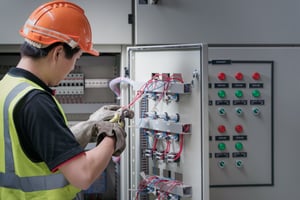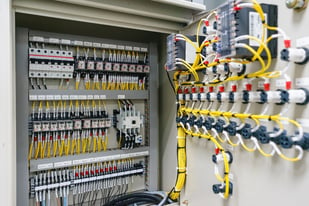Obsolescence is an unavoidable part of any manufacturing endeavour. No matter how well your company has planned, some factors are more challenging to consider in advance than others.

In the era of Industry 4.0, new technology continues to revolutionise the manufacturing industry. Industry professionals view it as the latest industrial revolution, hence the Industry 4.0 moniker. Big data and computing technologies are the front-runners in innovations proving value to manufacturers. It is more crucial now than ever to remain on the leading edge of new technology. Upgrading equipment to provide greater efficiencies will provide a greater return on the investment.
What Is Obsolescence in Manufacturing?
Obsolescence in manufacturing, as defined by the International Institute of Obsolescence Management, occurs when parts, services, and resources previously available are no longer produced by the original equipment manufacturer (OEM). It may also occur when the OEM has gone out of business. While the part, service, or resource may be difficult to come by, it is still needed. Therein lies the rub.
Every component comes with a life cycle, and it is impossible to repair or replace components that are no longer obtainable or extremely expensive to source from reputable suppliers that specialise in obsolete parts. The inevitable result is downtime in production, which impacts the bottom line.
How to Identify Obsolescence in Manufacturing Facilities
 Every product and industry is susceptible to obsolescence. We live in a world where innovation is happening at speeds faster than manufacturers can adapt to it, creating a colossal headache for industry leaders. To identify obsolescence, leaders should look for its defining characteristics. There are five kinds of obsolescence:
Every product and industry is susceptible to obsolescence. We live in a world where innovation is happening at speeds faster than manufacturers can adapt to it, creating a colossal headache for industry leaders. To identify obsolescence, leaders should look for its defining characteristics. There are five kinds of obsolescence:
- Technological obsolescence is the failure to develop or improve equipment, which results in a loss of an asset or a reduction in productivity. It can happen when equipment vital to an operation can no longer be serviced or repaired due to changes in technology and the unavailability of the components required to keep it in working order.
- Functional obsolescence occurs when an asset no longer supports the mission of the business due to degradation that affects its ability to perform to standards. It can include but is not limited to a physical location, structural inadequacies, access, and energy efficiency.
- Legal obsolescence refers to a legislative or another legal order that results in the prohibition of the use of critical assets. It may be part of an action to protect consumers.
- Economic obsolescence involves the retirement or replacement of a critical piece of equipment or infrastructure. It may have outlived its usefulness or is beyond economical repair.
- Aesthetic obsolescence is the least likely to affect manufacturing, as it generally refers to outdated interior furnishings and design style.
Contributing Factors
One of the biggest contributors to obsolescence is new technology. While it brings with it enhanced features for components, modules, software, and subsystems, new technology creates compatibility issues with older software and hardware. Other contributing factors include:
- Government regulations play a role in obsolescence to a degree. Changes in energy efficiency guidelines and safety features may prematurely push vital components of a business operation into obsolescence. Environmental policies and legislation constantly evolve and can restrict the use of materials required by some electronic equipment to function properly.
- Planned obsolescence also contributes to the problem, with some companies prescribing to the practice of designing products with a predetermined life span. Some companies do this to ensure their resources are allocated to developing newer technologies instead of producing outdated parts.
Consequences of Obsolescence
 Equipment failure resulting in downtime and loss of productivity is one of the most significant consequences of obsolescence the manufacturing industry faces. When legacy parts are out of commission, and there is not a reliable source for spare parts, it can create quite the ordeal and result in lost productivity. There is an added risk of damaging credibility with customers if a plant fails to meet anticipated output.
Equipment failure resulting in downtime and loss of productivity is one of the most significant consequences of obsolescence the manufacturing industry faces. When legacy parts are out of commission, and there is not a reliable source for spare parts, it can create quite the ordeal and result in lost productivity. There is an added risk of damaging credibility with customers if a plant fails to meet anticipated output.
Obsolescence increases costs for through-life support. Manufacturers are forced to strategically estimate current and future demand for components for vital equipment that are being discontinued. Predicting this kind of demand is difficult and can result in inefficiencies.
Avoiding the Obsolescence Pitfalls
Nearly 70 per cent of companies faced with obsolescence admitted to lacking full awareness of when vital equipment required repairing, replacing, or upgrading.
Manufacturers that hope to avoid the pitfalls of obsolescence need to focus on several crucial points as part of an obsolescence strategy.
1. What is critical to operational success
Manufacturers are advised to develop an obsolescence strategy to help lower the risks. There are three main aspects of obsolescence management, on which focus should be placed: a report of on-site components, risk analysis of those components, and identifying a specialist supplier to help plan and secure replacement parts.
2. The availability of resources
If the COVID-19 global pandemic taught the manufacturing industry anything, it was that it pays to plan ahead. For manufacturers, planning involves having a solid relationship with a middleman who can source hard-to-find parts. The availability of resources and obsolete components can mean the difference between continued production and prolonged shutdowns that result in a profit loss. Middlemen can locate alternative supply chains and help mitigate the risk of obsolescence.
3. Management of repairs
Components should be assessed based on whether they can survive a further occurrence of downtime. Locate external companies that provide year-round on-site emergency repair services whose emergency technicians can help manage repairs. It is imperative to group industrial parts based on their risk of becoming obsolete. Stockpile replacement parts in order of importance. Special quotes and last-time buy notices often accompany components that are about to become outdated. Be sure to account for warehouse space costs associated with storing spare parts.
4. Analysing upgrades
Manufacturers should analyse existing components to determine which need replacing before an immediate need for an upgrade occurs. It is better to purchase any new or used parts in advance rather than waiting until they are needed, only to discover they are obsolete.
5. A level of obsolescence that is tolerable
Even with a strategy in place to address obsolescence risks, it is impossible to plan for every scenario. Manufacturing companies must identify a level of obsolescence that is tolerable to their bottom line and build their plan around it.
6. Centralise the data
Once all of the above information is compiled, centralise it in a safe location. Creating a spreadsheet that details the condition of critical parts, how likely they are to break, and where to obtain replacement parts (either from storage or a direct supplier) is all most manufacturing facilities need.
7. Review, revise, and update
Obsolescence management is not a one-off review. Periodic reviews of the strategy and assessments of all critical systems and components must be conducted. Larger manufacturing facilities find it helpful to hire someone to oversee their obsolescence management efforts. Regardless of whether you assign an in-house staff member to conduct the reviews or hire an outside agency, regular reviews and updates can eliminate costly repairs and produce long-term savings.
Consult with the Professionals
 Martin Thomas, European Marketing Manager at Radwell said “In the current economic climate, it is more important than ever to manage your obsolescence risk. Radwell International’s team of automation experts can help address your facility’s obsolescence and develop a strategy for mitigating and ultimately eliminating risk.
Martin Thomas, European Marketing Manager at Radwell said “In the current economic climate, it is more important than ever to manage your obsolescence risk. Radwell International’s team of automation experts can help address your facility’s obsolescence and develop a strategy for mitigating and ultimately eliminating risk.
Radwell provides full-service assessments of all electronic equipment and offers consignment stock and full repair capabilities to keep your facility running 24/7. Contact us online or by calling 01782 576800 to find out more.









